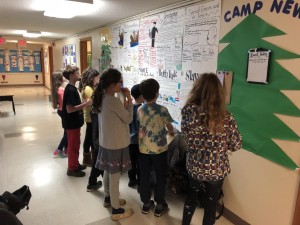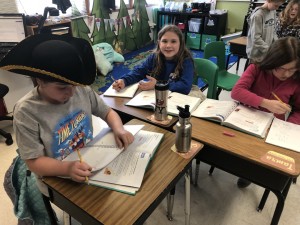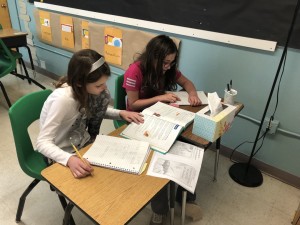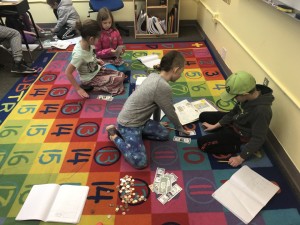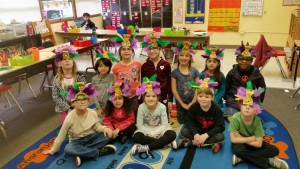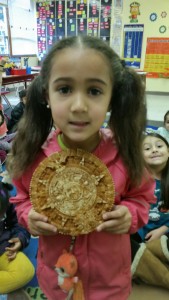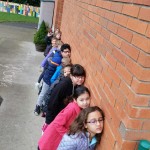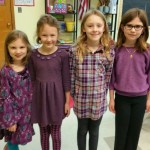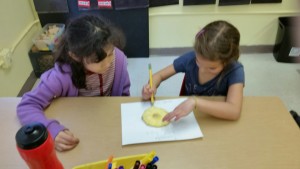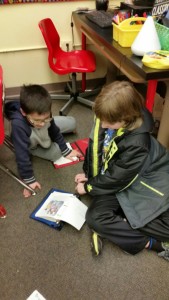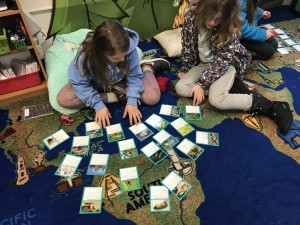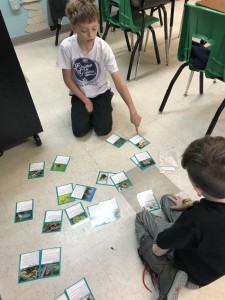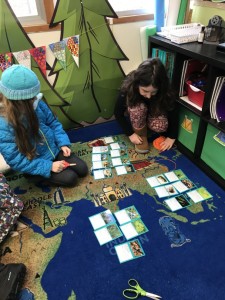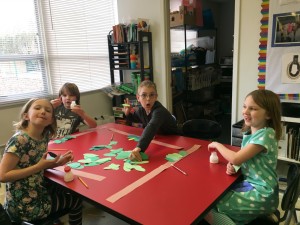4/5 Week 21 News
Literatura
This week we read the selection El rey de los espias de Yorktown, by. After going thought the vocabulary and the characteristics of this expository piece, maestra Paola read this selection aloud. The purpose for this was to model reading with fluency, expression and intonation- an area we have been focusing on in literacy. I conducted some reading assessments this week to evaluate thise objectives. Some students took home a “telephone” , a reading device used to listen to their voice when they read. We worked on the reading compression skill Drawing Conclusions.
Students are assigned to do some of their reading in Spanish aloud!
Congratulations to our students who did a remarkable job on their presentations of the American Revolution Project!
Ciencias
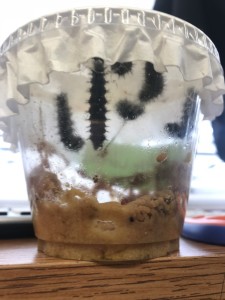 This week students continued to read about plants: their structure and needs in order to develop and grow. We read about photosynthesis and observed the growth of the plants we have in our classroom. Students took home a new science book. They are expected to read over the weekend and be back ready to discuss on Monday.
This week students continued to read about plants: their structure and needs in order to develop and grow. We read about photosynthesis and observed the growth of the plants we have in our classroom. Students took home a new science book. They are expected to read over the weekend and be back ready to discuss on Monday.
Learning Outcome:
- Plants make their own food by photosynthesis.
- Chlorophyll is the green pigment that absorbs sunlight in the cell of producer organisms.
- Green plant cells make sugar (food) from carbon dioxide and water in the presence of sunlight, and release oxygen.
How do animals get the nutrients they need?
Our investigations will focus on animal/human digestion next week. We have been observing the life cycle of the painted lady butterfly. I will go more in depth about the concept of digestion and the process used by animals to break down complex food items into simple nutrients.
History & Geography
This week we began studying Early Russia.
Our objectives were:
- Describe Russia’s early roots.
- Explain the impact of the Vikings on Russia.
- Summarize Christianity’s spread in Russia.
- Describe the impact of the Mongol invasion on Russia.
- Summarize the rise of Moscow.
- Summarize Ivan the Great’s early life.
- Describe how Ivan the Great ruled Muscovy.
- Explain the role of the serfs in Russia.
Mathematics
This week we continued working with Ratios.
Our objectives were:
- interpret ratios given in fraction form
- write ratios in fraction form to find how many times as large as one number another number is
- read and write ratios with three quantities
- express equivalent ratios with three quantities
- solve real-world problems involving ratios and fraction
- solve real-world problems involving ratios with three quantities
English Word Work
This week we completed our ration and began again.
Our rotation days were:
- Writer’s Workshop: This week students could choose between writing on our prompt (you find a mysterious door with a key what happens next?), revising past writing, or reading their writing to a classmate.
- Blind Sort Test: Students tested each other on their spelling using the Blind Sort method.
- Teacher Meeting: I met with each student to discuss and clarify their new sort
- Word Search: Students received a word search with their new spelling words. They were tasked with finding and sorting their new words.
Our spelling test will be Thursday February 15th!
Specialists
Character Education:
2/3 News Week 21
Literatura
This week we read Una capa para el soñador. Our objectives were:
- review what a prefix is
- understand how the prefixes in-, re-, des-, bi-, and tri- change the root word
- understand how to conjugate regular -ar -ir and -er verbs in the present tense
- use correctly words that indication location
- to use the comprehension skill Making Inferences as we read the story the second time
- to use comprehension strategies such as predicting, and summarizing to construct meaning from the story during the first read
We will not have a spelling test or reader homework during the next two short weeks!
Matemáticas
This week we worked with money! Our objectives were:
- add money in different ways without regrouping
- add money in different ways with regrouping
- Subtract money in different ways without regrouping
- subtract money in different ways with regrouping
History & Geography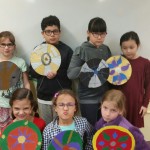
Social studies with Ms. Marci
This week we in our unit on the Viking Age we learned about sagas and swords. We discussed the how mainly the elite jarls had swords and how they were made. We also talked about the importance of sagas and the skalds who retold them. Students designed and painted their own Viking shields and made a model of Thor’s hammer as an amulet. For a writing response to our lessons, students could choose to use a Venn diagram or a T chart to compare and contrast two of our characters from the read aloud.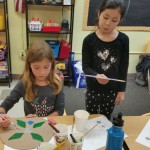
Our objectives were to:
• describe the Viking people’s proficiency and legacy at sailors, raiders, and traders
• explain that skalds were poets who memorized and retold Viking history through sagas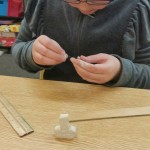
• identify the three orders of the Viking people: thralls, karls, and jarls
• explain that the Viking people built and used ships for different purposes
• recall that skilled blacksmiths lived during the Viking Age and name some items they made
• recall that the Thing was an assembly where the Norse made decisions for their community
Social Studies with Ms. Laura We continued practicing the play, “Victory at Marathon”. We learned about Athens under the leadership of Pericles, during the Golden Age of Greece. We talked about symposiums in Ancient Athens and used computers to explore decorative Grecian urns and then we designed our own! We planned our end of unit celebration, to take place on Tuesday, February 20th, when we will dress up as Greek gods or goddesses and bring homemade items to ‘trade’ at our Agora (market).
Science
This week we in our Light and Sound domain the class worked on their Alexander Graham Bell biographies. most of the students finished there rough draft and editing and our now typing there biographies. Those who are finished are working on an illustration to go with their paper. Our Light and Sound Science Fair will be on Monday beginning at 1:30.
Our objectives were to:
• describe the life and contributions of Alexander Graham Bell
• explain the significance of the invention of the telephone
• design some kind of illustration to go with your report.
English Word Work
We had our spelling test on Friday. In grammar we worked on prefixes and suffixes. In our journals we used the word “dingy” in one entry and also wrote about the idiom, “sound as a bell” in another.
Specialists
Character Education:
K/1 Week 21 News
Literatura
This week we completed our Nuestro vecendario en acción theme with a poem. Canción del trabajo provides a look into the people in our communities. This was a nice way for the students to see the unique qualities of poetry.
Our learning objectives this week were to:
- Clarify words or ideas they don’t understand from our oral stories.
- Identify words that rhyme.
- Identify words that are repeated.
- Distinguish consonant blends.
- Identify diphthongs and their spelling. (ai)
- Usea sequential writing map to plan a friendly letter.
- Write a friendly letter. Revise the letter. Send the letter.
Matemáticas
We continued working on our fact fluency. Have a strong grasp of our sums to 10 is very important.
Here is a video of our Math & Movement for fluency.
History & Geography
This week in our Early American Civilization unit we finished reading about the Aztec civilization. The class had fun finishing their Aztec headdress, learning about Aztec pictographs, singing a new song about the Maya, Aztec, and Inca. We also worked on our civilization chart.
Our objectives this week were:
• understand the Aztec had leaders
• understand that the Aztec established a vast empire in central Mexico many, many years ago
• identify the Aztec capital as Tenochtitlan
• recognize by name the emperor of the Aztec, Moctezuma.
• identify the area in which the Aztec lived
• recognize the significance of Hermán Cortéz to the Aztec
Science
This this week in our science unit our focus has continued to be on how matter changes and mixing matter. We finished reading our class matter book and wrote up observations on our pineapple experiment. On Friday we began a new investigation mixing water and salt and water and oil. Students predicted what will happen to our mixtures when we return to school on Monday.
Our objectives this week were to:
• understand there are three forms of matter; solid, liquid, or gas
• understand that matter can change or be a mixture.
• explain that matter can change in different ways, some changes are reversible and other changes are irreversible
• measure matter and observe changes over time.
English Word Work
This week we got our new sorts for spelling on Friday. Green group I worked on short vowels words with ending blends. Blue group reviewed “it”, “ot” and “at” word family words, Red group had “at” word family words.
Word wall words were: only, end, help, lot,
Vocabulary words were: headdress, noble, enormous, royalty, courteous, irreversible, reversible
In our journal we wrote about our matter that changes.
Specialists
Character Education:
4/5 Week 20 News
Literatura
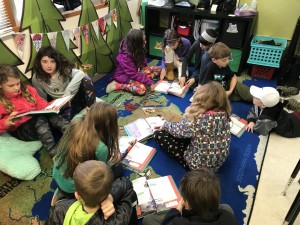 This week our reading selection was “The Midnight Ride of Paul Revere”. We studied the different elements of a narrative poem such a rhythm or meter – the rhythmic pattern of a poem. Students had already read this classic in English so they were able to establish great connections. Students concluded that a “translation” looses the poem’s original meaning and essence. It was still a great opportunity to talk about imagery and figurative language. The reading comprehension strategies and skills applied were : adjusting reading speed, clarifying, summarizing, visualizing, and author’s point of view.
This week our reading selection was “The Midnight Ride of Paul Revere”. We studied the different elements of a narrative poem such a rhythm or meter – the rhythmic pattern of a poem. Students had already read this classic in English so they were able to establish great connections. Students concluded that a “translation” looses the poem’s original meaning and essence. It was still a great opportunity to talk about imagery and figurative language. The reading comprehension strategies and skills applied were : adjusting reading speed, clarifying, summarizing, visualizing, and author’s point of view.
Writing
We had so much fun this week working on our writing project! After reading the piece “American Revolution”, students were assigned to craft a writing piece from the perspective of a settler/ Native American during the American Revolution war. Students spent the week developing their characters. This is probably one of our favorite projects so far! Students were given a rubric that states all the requirements for the project. I had the opportunity to conference with students at the end of the week to help facilitate the editing portion. I was very impressed to see everybody meeting, if not all, most of the requirements for this project. As a culminating piece, students will get to read their pieces to the class next week on Tuesday and Friday. They are encouraged to “dress the part”. Families are more than welcome to come celebrate with us the amazing writing happening in the 4th/5th grade class!
Ciencias
Yeast Nutrition: What does yeast need to break its dormancy?
This week, students conducted an investigation to determine the necessary conditions for activating dry yeast. This investigation was directly connected to this week’s Health studies with Ms. Leann, about oral hygiene.
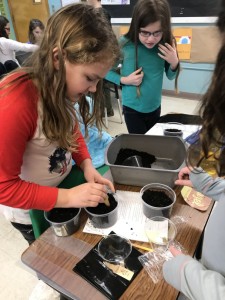 Plant Nutrition: How do plants get the food they need?
Plant Nutrition: How do plants get the food they need?
Students thought about how to break the dormancy of another organism, the wheat plant. They planted wheat seeds in containers of soil and placed half of the planters in a lighted environment and the other half in a dark environment. Students read about the action of chlorophyll and its role in the manufacture of sugar. They will observe their plants to determine which plants have chlorophyll. Students are predicting that the plants growing in light are the ones prepared to produce food to provide nutrients for their cells.
Learning Outcome:
- Plants make their own food by photosynthesis.
- Chlorophyll is the green pigment that absorbs sunlight in the cell of producer organisms.
- Green plant cells make sugar (food) from carbon dioxide and water in the presence of sunlight, and release oxygen.
History & Geography
This week we continued learning about European Explorers.
Our objectives were:
- Summarize the journeys of Hernán Cortés, Francisco Pizarro, and Vasco Núñez de Balboa.
- Describe the outcomes of the voyage made by Ferdinand Magellan and his crew.
- Explain the significance of a Northwest Passage.
- Summarize the voyages of John Cabot.
- Explain the role of England’s East India Company.
- Summarize the voyages of Giovanni da Verrazano and Jacques Cartier.
- Summarize the expeditions made by Henry Hudson.
Mathematics
This week we started working with Ratios.
Our objectives were:
- read and write ratios
- find equivalent ratios
- solve real-world problems involving ratios
English Word Work
This week we began our rotation.
Our rotation days were:
- Word Search: Students received a word search with their new spelling words. They were tasked with finding and sorting their new words.
- Teacher Meeting: I met with each student to discuss and clarify their new sort
- Vocabulary Day: This week our lesson was about antonyms. The vocabulary words we will be adding to our wall are
- Spelling City: Students had a chance to work on computer skills as well as spelling on spellingcity.com. If your kiddo would like to work on spelling city at home they can follow this link www.spellingcity.com/users/34SpellingSWS
Our spelling test will be on Tuesday February 6th!
Specialists
2/3 News Week 20
Literatura
This week we read El gato que se volvió poeta. Our objectives were:
- understand what the digraph ll sounds like
- understand the suffixes -ado and -ción
- understand how nouns, adjectives, and articles change according to number (singular or plural) and gender (masculine or feminine)
- to use comprehension strategies such as predicting, summarizing, and asking questions to construct meaning from the text
- use the comprehension skill Fantasy and Reality as they read the story for the second time
Matemáticas
This week we wrapped up our chapter on Using Bar Models: Multiplication and Division. Our objectives were:
- use bar models to solve two-step word problems
- choose the correct operation to solve two-step word problems
- review using bar models to solve different types of multiplication and division problems
- demonstrate using bar models to solve different types of multiplication and division problems on the chapter test
Our next chapter will be Money!
History & Geography
Social studies with Ms. Marci.
This week we in our unit on the Viking Age we read more about Viking Family Life. We discussed reasons why Vikings traveled, trade, raid, and to explore new lands. Students made a model of a longship. We also watched a short video on what daily life might be like in a Viking village, and read Norse mythology stories about Thor. Students wrote about a Norse child’s morning routine and their own morning routine, comparing and contrasting the two.
Our objectives were to:
• explain that only the warriors who went on raids to other lands were actually called Vikings
• explain how and why the Vikings traveled to other countries
• recall that Viking people relied on farming, fishing, and trade for their living
• describe the everyday life of Viking people
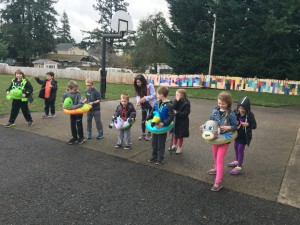 Social Studies with Ms. Laura We talked about the history of The Olympics and held our own Olympic games, SWS style! We learned about, through reading and computer use, The Persian Wars and the unlikely victory for the Greeks over the powerful, and numerous, Persians. We started reading through, and practicing parts, for a play about one of the battles of this war, “Victory at Marathon”.
Social Studies with Ms. Laura We talked about the history of The Olympics and held our own Olympic games, SWS style! We learned about, through reading and computer use, The Persian Wars and the unlikely victory for the Greeks over the powerful, and numerous, Persians. We started reading through, and practicing parts, for a play about one of the battles of this war, “Victory at Marathon”.
Science
This week we continued with our Light and Sound science domain. We reviewed what we have learned so far and watched a Bill Nye video on sound. The class worked on their Alexander Graham Bell biographies. On Thursday a note about our upcoming science fair on light and sound came home. In this note you can find details on expectations and requirements for this activity. On Friday we worked took our unit assessment.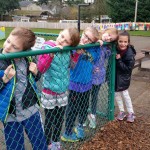
Our objectives were to:
• describe the life and contributions of Alexander Graham Bell
• explain the significance of the invention of the telephone
• review what we’ve learned this unit so far
English Word Work
We had our spelling test on Friday. In grammar we worked on pronouns and suffixes. In our journals we used the word “irrate” in one entry and also wrote about either the proverb, “actions speak louder than words” or Groundhog day.
Specialists
K/1 Week 20 News
Matemáticas
This week we continued learning to add two-digit numbers and one-digit numbers by grouping the two-digit number into a 10 and ones using place value.
Our objectives were to:
- Add using doubles facts.
- Memorize doubles facts up to 9+9 (please try this at home too so they become automatic.)
- Recognize doubles in addition sentences.
- Identify doubles plus one facts (6+7 is the double 6+6 plus 1)
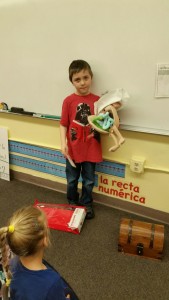 History & Geography
History & Geography
This week in our Early American Civilization unit we continued to read about the Aztec civilization. The class had fun planning their Aztec headdress. We will be making these in class next week. We also watched a short film on Groundhog day.
Our objectives this week were to:
• understand that the Aztec farmed
• identify the area which the Aztec lived
• understand the Aztec have leaders
• identify the Aztec capital as Tenochtitlan
• recognize by name the emperor of.the Aztec, Moctezuma.
Science
This this week in our science unit our focus has been on how matter changes. We read a matter book and began working on a class book. We also cut up a pineapple into slices and measured it’s diameter and then began to dry it in the window. We will mearsure it again next week looking for proof of evaporation and how matter can change.
Our objectives this week were to:
• understand there are three forms of matter; solid, liquid, or gas
• understand that matter can change or be a mixture.
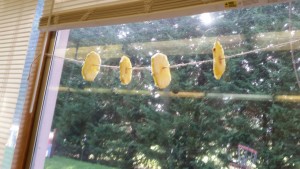 • measure matter and observe changes over time.
• measure matter and observe changes over time.
English Word Work
This week we got our new sorts for spelling on Friday. Green group I worked on short i, o, u, and beginning blends. Blue group worked on k, wh, qu, tw, diagraphs, Red group had v, y, and z sound sorts.
Word wall words were: got, does, just
Vocabulary words were: chinampas, mixture, emperor
In our journal we wrote about Groundhog day.
Specialists
4/5 Week 19 News
Literatura
This week we finished reading our non-fiction piece La revolucion estadounidense. After discussing and summarizing the main ideas of the text, we focused on organizing and categorizing information (this skill transferred directly to our science studies), as well as providing examples of cause and effect situations drawn from the story. These are very significant reading and comprehension skills. Students did an excellent job identifying and explain these situations applying accurate vocabulary and structure in Spanish both, orally and in written form. Also in literacy, we continued to work on our regular spelling, grammar, usage and mechanics routines (literacy packets).
Towards the end of the week, students were introduced to a new writing project we will be working on the next couple weeks! We are all so excited about this new project. More information to come, please stay tuned!
Ciencias
Is planet Earth a system? What happens when compost worms interact with organic litter?
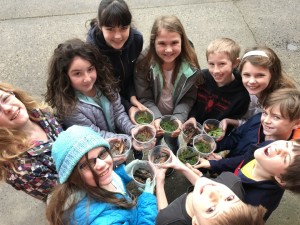 This week students continued to explore Earth as a system. Students focused on the biosphere and described ecosystems by looking at feeding relationships and energy transfers, described as food webs. Each group of students set up a redworm habitat system to study detritivores. They will record what organic materials go into the habitat with about redworms and will observe and document changes in the worm jar over the next weeks.
This week students continued to explore Earth as a system. Students focused on the biosphere and described ecosystems by looking at feeding relationships and energy transfers, described as food webs. Each group of students set up a redworm habitat system to study detritivores. They will record what organic materials go into the habitat with about redworms and will observe and document changes in the worm jar over the next weeks.
Key concepts discussed :
- Food webs are subsystems within ecosystems. They describe the transfer of matter and energy within the system.
- Food webs are made up of producers (organisms that make their own food), consumers (organisms that eat other organisms to obtain food), and decomposers (organisms that consume and recycle dead organisms and organic waste).
History & Geography
This week we began learning about European explorers.
Our objectives were:
- Describe the location of the Spice Islands.
- Explain why spices were valuable to Europeans.
- Summarize how Marco Polo’s journey served as an inspiration for European exploration.
- Explain why Europeans needed spices
- Identify new technologies that allowed Europeans to launch voyages of exploration.
- Explain why Portugal launched missions of exploration.
- Summarize the voyages of Bartolomeu Dias, Vasco da Gama, and Pedro Cabral.
Mathematics
This week we completed our unit on Area of a Triangle.
Our objectives were:
- Identify the base given the height of a triangle
- identify the height given the base of a triangle
- Find the area of a triangle given its base and its height
English Word Work
This week we completed our rotation.
Our rotation days were:
- Vocabulary Day:
- Spelling City:
- Writer’s Workshop:
- Blind Sort Test:
Specialists
- Someone who likes to tell everyone what to do and how to do it.
- Someone who is often a leader but can not control the urge to bluntly tell others what to do.
- The student is not aware of their bossiness, it’s an automatic behavior.
- Someone who feels it’s their job or responsibility to make sure others get everything done.
- It does not matter if someone else was assigned the role of leader, this student will assume the role of the boss.
- Other students may follow this student, but eventually will complain about the bossiness.
- Other students may avoid being in a group with this student.
We had a great discussion on how we can help a friend realize they’re being bossy and instead be a leader.
- Leaders SHOW by example instead of telling others what to do.
- Leaders listen to other’s ideas.
- Leaders resist the urge to interrupt or cut off others when speaking.
- Leaders resist the urge to speak too quickly (giving themselves time to really think about what others are saying).
- Leaders add to discussions using polite transitions like “May I add” or “That’s a great idea, I was also thinking..”.
- Leaders gather the information they need so when they speak it is not just to be the one talking, but speaking with knowledge.
- Leaders ask others for their opinion or ideas.
- Leaders don’t offer critique unless asked to do so.
Art:
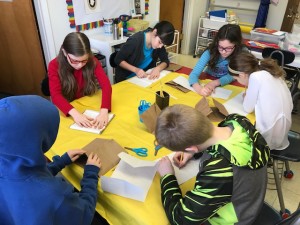 During January, the students learned about the origin and meaning of Native American Dream Catchers. They used wrapped wire to form a circular loom, and then added yarn to create a web pattern to “catch” the bad dreams.The good dreams are allowed through the center of the web and travel down a line of beads and feathers to the person sleeping. It was fun looking at the beautiful and unique dream catchers that everyone made. The students noticed that some of the dream catchers had flower designs like dahlia or sunflower petals, and others had geometrical shapes that looked architectural. Fabulous job everyone!
During January, the students learned about the origin and meaning of Native American Dream Catchers. They used wrapped wire to form a circular loom, and then added yarn to create a web pattern to “catch” the bad dreams.The good dreams are allowed through the center of the web and travel down a line of beads and feathers to the person sleeping. It was fun looking at the beautiful and unique dream catchers that everyone made. The students noticed that some of the dream catchers had flower designs like dahlia or sunflower petals, and others had geometrical shapes that looked architectural. Fabulous job everyone!
The students also learned about an art form of the Nez Perce and Great Plains tribes. The students created a Parfleche, which is an envelope type bag traditionally made from buffalo hide that was used to carry various household goods when the tribe was traveling. The students used geometric designs to decorate a parfleche which they made from brown paper bags. The students will add the leather strings to the bag in February.
We have also enjoyed looking at the amazing portrait drawings that Tamra has made of some of her classmates. And Owen brought in a beautiful collection of a wide variety of Origami pieces that he has been working on at home.
On January 31 and February 7, I will be out of town, and our art substitute Miss Karen will be providing some wonderful lessons on Native American pottery, using real clay and glazes! It would be helpful for the students to bring a clean plastic container (from salad mix or berries, etc.) to transport their clay pieces home when they’re finished.
2/3 News Week 19
History & Geography
Social studies with Ms. Marci.
This week we in our unit on the Viking Age we read more about Viking Life and learned about Viking raiders and traders. We reviewed what narrative and point of view in writing meant and then rewrote a first person narrative paragraph into a 3rd person point of view paragraph. The students also wrote a descriptive piece using adjectives and their senses to describe a Viking village.
Our objectives were:
• identify and locate Scandinavia as the area from which the Vikings originated
• locate Iceland on a map
• explain how and why the Vikings travel to other countries
• explain that the Viking people worshipped many gods and goddesses
• describe the everyday life of the Viking people
• explain that the Viking people built and used ships for different purposes
• describe the Viking people’s proficiency and legacy as sailor’s, raiders, and traders
• explain that only the warriors who went on raids to other lands were actually called vikings
• locate the areas to which the Vikings traveled
We talked about some of the many differences for children in the Ancient Greece city-states of Athens and Sparta. We made charts describing life as a boy and as a girl in each of these locations. Very different, indeed! We started preparing for our own Olympic Games, SWS Style, which will take place on Tuesday, January 30th during class.
Science
This week we continued with our Light and Sound science domain. In our read aloud we learned about the voice and began to read about Alexander Graham Bell. Next week students will begin to write a short biography on…
Our objectives were to:
• compare and contrast light and sound
• describe how the intensity and frequency of vibrations affect the qualities of sound
• identify the parts of the body that create the human voice
• explain how the human voice is produced and is able to make a wide range of sounds
• Describe the life and contributions of Alexander Graham Bell
• explain the significance of the invention of the telephone
English Word Work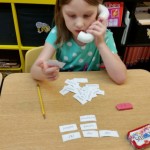
We had our spelling test on Friday. In grammar we worked on adjectives. In our journals we used the word “hurl.” in one entry and they also wrote about the proverb, “actions speak louder than words” in another.
Specialists
Character Education with Maestra Sarah: For the next couple week’s we are working on a citizen project. We talked about how doing and saying kind things for others makes them feel happy. We don’t do acts of kindness because we want something in return. We are working on random acts of kindness. Students will share their acts of kindness on our school-wide bulletin board.
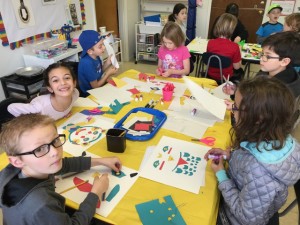 In early January the students watched a Power Point presentation about Totem Poles of Pacific Northwest Coast Native Americans. They learned how and why Totem Poles were made and they learned about the special shapes and patterns used in various artwork of Pacific Northwest Coast Indians. Students practiced drawing the various eye shapes, and Ovoids and U shapes that are prevalent in Totem Pole designs. Then they chose an animal and started a sketch of how that animal would look using Totem Pole shapes.
In early January the students watched a Power Point presentation about Totem Poles of Pacific Northwest Coast Native Americans. They learned how and why Totem Poles were made and they learned about the special shapes and patterns used in various artwork of Pacific Northwest Coast Indians. Students practiced drawing the various eye shapes, and Ovoids and U shapes that are prevalent in Totem Pole designs. Then they chose an animal and started a sketch of how that animal would look using Totem Pole shapes.
At the next class, the students used their sketch as a pattern to cut out various shapes from construction paper, and then glued these to poster board. Several students added 3-dimensional beaks or ears to their totem animal. I’m impressed with how hard everyone worked on this project! These great Totem Pole designs are on display at the end of the hallway!
The students also learned about the significance of salmon fishing to all Pacific Northwest Native Americans, and they made beautiful drawings of Sockeye Salmon using oil pastel.
This past week we discussed the Nez Perce and Yakama tribes and the importance of horses to these and other Native American tribes. The students learned that the Nez Perce create beautiful bridles, saddles, and other ornaments for their horses to wear in celebrations and parades. The students designed their own horse ornament using the simple geometrical shapes that New Peace artists use. We’ll add the finishing touches later in February.
On January 31 and February 7, I will be out of town, and our art substitute Miss Karen will be providing some wonderful lessons on Native American pottery, using real clay and glazes! It would be helpful for the students to bring a clean plastic container (from salad mix or berries, etc.) to transport their clay pieces home when they’re finished.

